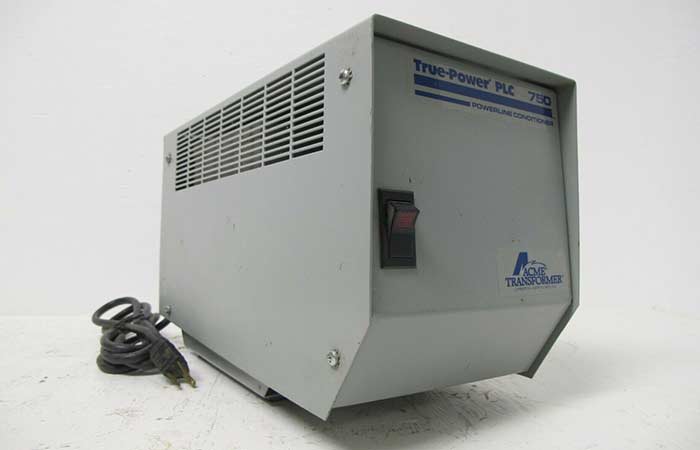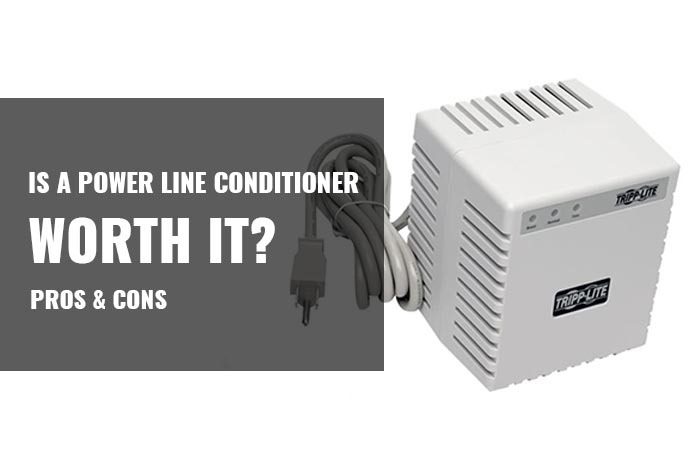If your generator is not the inverter type, it is not wise to use sensitive electronics such a TVs, phones and computers with it. This is because open frame portable generators have a high Total Harmonic Distortion (THD) which can damage the electronics permanently. Any THD of more than 5% is enough to damage electronics at times permanently.
The solution to that is installing a power line conditioner. This is a device meant to eliminate or reduce the Total Harmonic Distortion level of the power from the generator to safe levels such as below 5%. This device should always be used with non-inverter generators if at all you’ll be running electronically sensitive devices.
What Is a Power Line Conditioner?
A power line conditioner is a device meant to stabilize the voltage of the power produced by portable open frame generators. This device comes in handy when there are overvoltages and brownouts to keep the voltage steady for the electronics.
Basically, a power line conditioner has the role of canceling out any noises and fluctuations in the power thus ensuring that the electricity fed into the electronics is stable and won’t affect their workings.
Power line conditioners, however, don’t clean up the modified sinewave that’s found on most open frame portable generators. This means that it’s not all that bulletproof as some disturbances can still reach the electronics and cause damage.

What Does a Power Line Conditioner Do?
When electricity is fed into the power line conditioner, it’s smoothed out by eliminating any fluctuations in the voltage and any other noises it may have. This ensures that the power reaching the electronics is stable and doesn’t negatively affect them.
Besides stabilizing the power, power line conditioners also have surge suppression hence will do the same job as a surge protector besides the other tasks. In fact, power line conditioners are better at surge protection when compared to surge protectors as they can smooth out large power surges and on multiple devices as well.
For North America, the electronics are meant to run at the general supply of 120VAC and 60Hz of power. While generators will supply this exact amount even without an inverter, the engine will keep fluctuating to the extent that the power supplied doesn’t stay steady. For example, when the power needed is higher, the generator will have a higher speed which leads to a higher number of Hertz (Hz) and vice versa.
Why You May Need a Power Line Conditioner (Pros)
The reasons why you need a power line conditioner on your generator include the following:
1. Prevents power fluctuations
The primary role of a power line conditioner is to eliminate power fluctuations during periods with overvoltages and brownouts. Generators without an inverter also tend to provide unstable power hence the need for stabilization by a power line conditioner.
2. Protects devices from damage
When power fluctuations are taken care of, power-sensitive electronics such as TVs, phones and others can be used without any risk of damage. This is vital to the functioning of the electronics and their safety as well.
3. Keeps wires cool
When there’s overvoltage, wires and devices connected to the power lines tend to heat up. With a power line conditioner, your wires and electronics won’t have to deal with large amounts of power than they can handle hence will remain cool. Overheating wires and electronics are a fire hazard which are taken care of by the line conditioners.
Why You May Not Need a Power Line Conditioner (Downsides)
You may not need a power line conditioner for the following reasons:
1. You don’t run sensitive electronics
If you use your generator to run electronic devices that aren’t sensitive to changes in the power, you don’t need a power line conditioner as they can handle fluctuations.
2. When the devices are sensitive to modified sinewave
While they do a great job at steadying the voltage of the power from generators and other sources, power line conditioners don’t smooth out the modified sinewave that is often typical of power from generators.
As such, a power line conditioner is not the best solution for power fluctuations and other issues. Instead, get an inverter/rectifier is you truly want to supply your house with clean power. The inverter also steadies the modified sinewave making the power stable and steady.
Are there whole house line conditioners?
Yes. There are line conditioners for the whole house. With power line conditioners, you can choose the one with the right amount of power rating to use for your house with some line conditioners having wattage ratings in the tens of thousands which is enough for most homes.
Common Features of a Power Line Conditioner
The most common features found on power line conditioners include the following:
1. Outlet on the front
The outlets on the front are extra outlets for charging small devices such as phones, microphones and others. They’re important additions as they provide some extra ports for use with USB devices and other portable electronics.
2. Input voltage display
This is one of the most important features of power line conditioners as it shows how much power is being fed into it and how it changes. Given that the input of open frame generators varies with time, this display will often show various changes in the voltage of the input. The good news is that the power you use on your devices won’t be ranging like the input as it’s smoothed out by the line conditioner.
3. Power switch on the front
While a good number of power line conditioners will have a switch for each outlet, you also need one switch to turn off all the outlets at once. Having a power switch for this purpose will increase the convenience of using the line conditioner and keeping it safe as well when the need arises.
4. Extendable Lights
The extendable lights help you see the power line conditioner in the dark or when the lights become dim. It’s helpful when you need to switch on an outlet or generally use the line conditioner. Not all line conditioners will have this feature though.
5. Outlets and switches
The number of outlets depends on the size of the power line conditioner. For most people, about 12 power outlets will be enough to work with. Check to ensure that the ports are the right type for your electronics. Luckily, the US uses a single type of power outlet.
As for the switches, each port should ideally have a switch of its own. This helps keep the power line conditioner safe as you can only turn on the power outlets you want to use. You can also have one large switch for all the outlets.
6. Cord
The length of the cord will differ as different power line conditioners will have different lengths of their power cord. Check for a power cord that’s long enough to reach your house while keeping the generator far away.
Some power line conditioners will have more features than the ones listed here. If any of the additional features are important to you, always consider them before buying the line conditioner.
What to consider when shopping for a line conditioner
The aspects to put into consideration when choosing a line conditioner for your generator include the following:
1. The cost
A good power line conditioner will cost you several hundreds of dollars especially when it’s for running many electronics and working with a large generator. There are good power line conditioners at about $200 which we would easily recommend for anyone in need of stable power from their generators.
As with all items, lower prices don’t mean you’re getting a bargain. Instead, you’re likely getting a cheap and low-quality power line conditioner which may end up frying your electronics. Also, getting a costly one isn’t a guarantee of quality as some are simply brand names but with a low quality. Always check the reviews of the line conditioner from previous owners before buying one.
2. Power quality issues
Power conditioners aren’t an all-in-one solution for power problems as they don’t perform all tasks. Some common power problems include high or voltages, power pollution and fluctuations. Other issues include common-mode noise and radio frequency interference. You need to know exactly what problems your power source experiences then go for a power line conditioner that solves it. You need to know that different power line conditioners are meant for different purposes.
3. Cord length and power outlets
The length of the cord determines how far you can place the power line conditioner from the generator. You need a cord that’s long enough to place the generator as far away from the house as possible to keep the noise down and prevent poisoning from the carbon monoxide released from the generator. While you can easily extend the cord with a similar wire, it’s always cleaner and safer to use the original cord.
On the part of the outlets, you need as many outlets as the number of electronics you have. Most power line conditioners will have about 10 to 12 outlets (ports) which is enough for most electronics. You can also increase the number of power outlets with an extension cable of your choice.
4. Power capacity
You need to choose the right power line conditioner for your size of the house. This means that you will need to get one that has the amount of power generated by the generator. Failure to match the power capacity can be disastrous as it means you won’t be taking care of the electronics well. In this regard, you should go for a power line conditioner that is more than the power drawn from your generator. For example, if your electronics draw 3000 watts of power from the generator, get a power line conditioner that’s more than 3000 watts.
5. Safety and durability
The quality of the power line conditioner determines how safe your devices and the house in general will be. Durability can be in the form of the quality of materials used to construct the line conditioner. Go for power line conditioners built with quality materials such as metal covers, wooden casings and properly insulated wires for safety. Also, check for safety features such as being fireproof and having a signal for when the line conditioner is protecting your devices or not. A blue and red light is used for most power line conditioners.
6. RFI/EMI protection
Most power line conditioners in the modern age have both RFI and EMI protection. This means that they also protect your devices from EFI and RFI interferences. This adds another layer of protection to your devices which is paramount in preventing damage and other issues.
7. Mountable rack design
To keep the rack off the ground where it can be tripped over or splashed with water, you need to hook it up somewhere. Having a mountable rack design means that you can place it on a rack of your choice to keep it safe and out of the way. If you have a rack already, measure it to ensure the power line conditioner you get fits into it.
8. Size
The size of the power line inverter should be small enough to fit into most places in the home. It should be as small as an extension cable to save on space and keep the house clean.
9. Warranties
Most power line conditioners come with 2 years of warranty which is a good period. If you can find a quality one with a longer warranty, the better for you.
A power line conditioner is important as it helps prevent power brownouts, surges and other fluctuations from damaging your electronic devices. Before buying one, check its specifications to match them with your power supply. Also, ensure the cord is long enough to safely and quietly use your power source. Beyond that, you need to check for safety features on the line conditioner.
